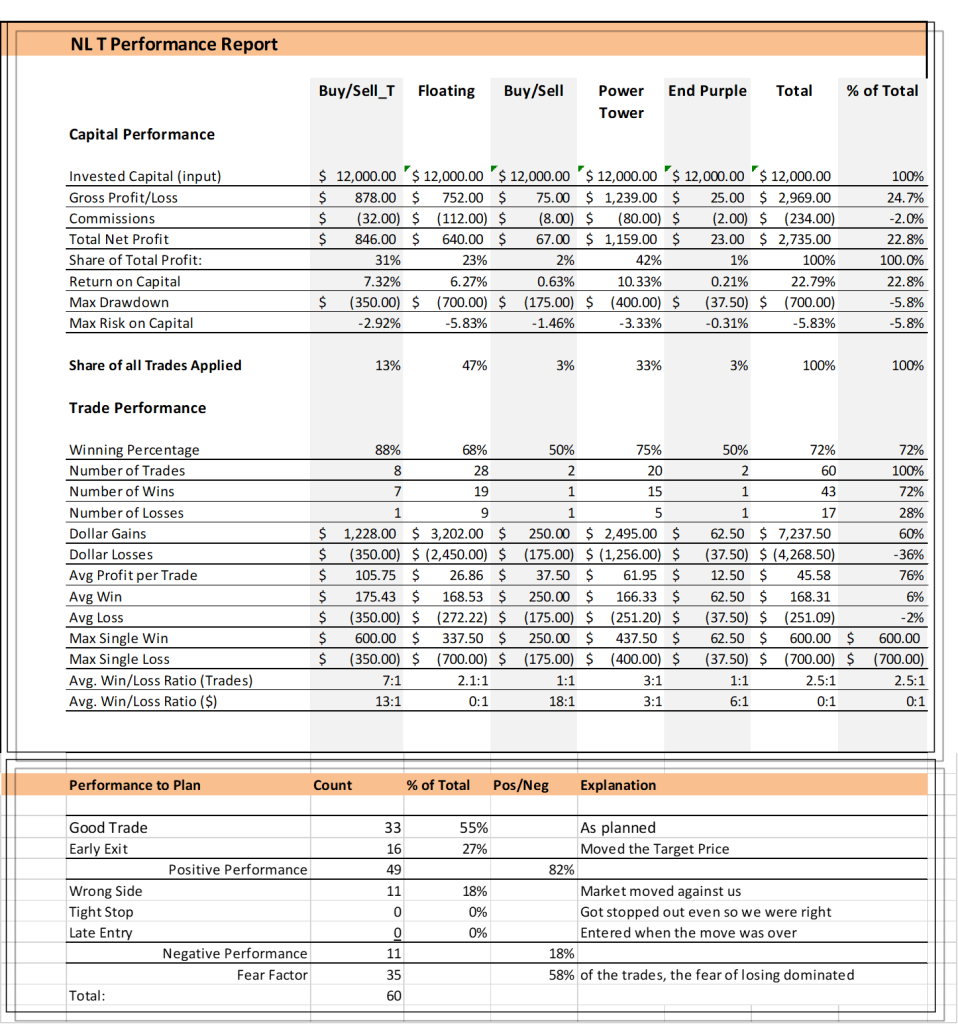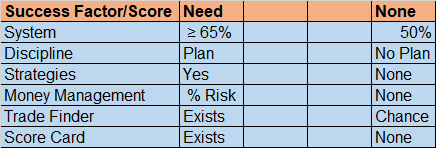If trading were easy, nobody would ever go to work; however, it is learnable: Trading Success has a structure: a path to learn and follow; this is what we share here with you.
On the path to trading or investing success, structure matters. We use the words trading or investing synonymously, behaviorwise the same is required:
- Traders hold open positions for shorter periods (day trading, swing trading)
- Investors hold positions for weeks, months, years
When your way of trading or investing gives you random results, spare the effort of optimization; change is inevitable. Instead, we want to help you to structure your trading and investing goals so you can be consistent.

We all possess a human psychological need to find a reason for what we did in the past and justify our doing. Hence, people praise the trading success they had and do not talk about the losses they made. However, your account statement strikes a balance, and if it is not positive or at your expectation rate, it is time to make a change in 2023 to develop yourself into the trader or investor you want to be.
When we talk about a path to success, what are the critical elements to make you a consistent trader or investor?
We are more than ten years in the trading education business, and here are the essential elements we see:
Critical Elements for Trading Success
| Usual | Success Factor | Needed |
| Average 50% – 55% or no system with interpretation on entry and exit | System | High probability ≥65% with hard-coded entry and exit rules |
| Trading at free will with open decisions of when and how to trade | Discipline | Following a plan of when to trade, how often, and minimum expectations to accept a trade |
| One trading strategy to follow and strategy change when losing trades | Strategies | Multiple risk-limiting strategies related to chart setups and the assets |
| Equal risk allocation or high-risk acceptance without rules | Money Management | Allocation rules for the risk to take and trade repair ability |
| Focus on limited assets, regardless of the stage of a price move they are in | Trade Finder | Own a market scanner or subscription to system-based market alerts |
| No performance measure in fear of making transparent to yourself what does not work | Score Card | Keep a record of what worked and what did not. Continue what worked and strive for constant improvement |
In trading, you accept decisions under a high level of uncertainty. About 10,000 times higher than those experienced in other professions; hence, you will only emotionally survive the trading pressure with a structure.
Let us explain a bit further:
Would a 75% chance for success be something you say would help you to achieve your trading and investing goals?
We know this was an unfair question, but we are an algorithmic trading house. As such, we are quantifying opportunities and operating with measurable approaches, eliminating emotional decision-making to a very high degree. You need a system that provides you the basis to form mechanical decisions when specific setups occur on your charts.
System
In your trading decisions, you want to find a way to separate signal from noise:
- Signal: directional price move indication
- Noise: random price move indication
Average trading systems are past-oriented and mostly lag behind the actual happening this is why their likelihood to forecast future price moves is 50% to 55%. On the other hand, high-probability systems start at 65% accuracy.
Let us quickly calculate the difference in the expected trading result between a model with a 55% probability to one of 65%. First, what is the likelihood of winning six or more out of ten trades? Then, we calculate the expected chance with the help of the Bernoulli experiment. Please let us take a shortcut here:
- A 65% system gives you a 75% chance to predict and win six or more out of ten trades
- A 55% only gives you a 50.4% chance for six or more winners (random predictability)
Now, you know why we propagate high over low probability for retail traders.
We offer several systems: TradeColors.com is our beginner system and is included in all other systems. In this publication, we like to share a combination of NLT Top-Line, Trend Catching, and NLT Timeless Indications.
NLT Top-Line has multiple price charts and lower study indicators for trading at crucial price turning points:
- Strong Price Turning Points: NLT Power Towers stand tall and point a direction (blue and red, buy> and sell<)
- Tops and Bottoms: NLT Early Buy or Sell, pointing out more considerable directional price moves (orange buy>, sell<)
- End of Purple Zone. We color up-moves in blue and down-moves in red; when there is a time of ambiguity in price direction (purple buy> and sell <).
- Strong money in our outflow, showing institutional engagement (lower study)
- Correlated or uncorrelated to the overall market move (lower study)
- Historical price projection to understand what others expect (upper and lower study)
- and more
NLT Trend Catching differentiates
- Trend Initiation Signals (gray buy > and sell <)
- Trend Continuation Signals (gray Buy_C and Sell_C)
- Balance of Power: Buyers or sellers in Charge
Many of our clients combine systems for a higher participation rate: more trades and accuracy with uncorrelated indicators.
Let us get into some chart examples that include our hard-coded rules for entry and exit: another crucial system component in giving you a higher chance of winning.
In the first example, you see a Timeless NLT Day Trading Chart, where we combine NLT Top-Line and Trend Catching. On our timeless charts, candles construct themselves purely price based, defined by the system – time is not a consideration; this helps traders to achieve:
- Trading at crucial price turning points
- Trade situations with system-specified acceptable risk/reward setups
- Acting less predictable by following principles other market participants cannot predict easily, while it is pretty evident on time-based charts, where stop-loss orders sit.
NLT Timeless Day Trading Examples /ES

On January 6, 2023, between 8:30 a.m. and 3 p.m. ET, nine trading opportunities were indicated: seven winners and two losses (78%).
Swing Trading Example QQQ

The QQQ chart shows a swing trading example, and you see multiple directional indications with buy and sell thresholds: Buy > or Sell <, and we only act if the set number is reached in the price movement of the next candle. The holding time is a couple of days. Dots specify trade targets, and red crossbars are the stop levels.
If you want to hold open positions for multiple weeks, the SPX provides a solid basis for longer-term positions. Again, you will find buy and sell indications with thresholds; horizontal lines build express supply lines on pullbacks, where we propose to exit in the current overall bear market.
Swing Trading Example SPX

The SPX chart shows six trade situations where five worked according to plan and one failed.
Discipline
People from different professions tend to apply a work strategy in trading: trying to trade often and hard when the week starts. However, this is not a fruitful way to act in the financial markets. Trading/investing is a professional business; professionals follow defined principles and act only when specified conditions are met. With our systems and strategies, this is the principle we follow, and we only trade on pre-defined setups, encouraging our clients to pursue a business plan for trading success, which consists of:
- Action plan: when to trade and when not
- Financial plan: how often to trade and which returns to expect
In our mentorships, those written plans are generated jointly and followed by successful clients.
Are you ready to create and follow a business plan for trading success?
contact@NeverLossTrading.com Subj.: Demo
Strategies
Trading strategies are a wide range of topics and depend on the holding time you desire for open positions. If you are day trading, one of our strategies is to focus on two assets with NLT Timeless Concept setups, giving you a sound basis for high probable configurations. We encourage you not to focus on endless opportunities but to act, produce a pre-defined daily income and then close the books. We call this idea: less is more or – = +, and if you like to learn more about this, we are happy to send you a referring article as PDF:
contact@NeverLossTrading.com Subj.: less is more
As a swing trader or longer-term investor, gaps can produce an extraordinary overnight risk. However, there are actions you can take to limit the overnight risk:
- Trading options of underlying assets, limiting the risk to the premium paid with upside leverage when your directional price move example works.
- Combining stocks and options for additional income and additional protection. We share our NLT Delta Force Options Trading concept in our mentorships. The concept defines the options delta to act upon, the time to expiration to pick, the maximum price to pay, or the premium to collect
- Hedging portfolio holdings with futures trading strategies, covering potential counter price moves six out of seven days where orders will be auto-released based on specified conditions, to secure your portfolio value or even leverage it
Trading involves multiple elements of knowledge and a lack of one of the success factors can already be detrimental to achieving your desired results.
Money Management
When you have all ducts in a row and you produce constant income from the financial markets, we encourage you to be 80% invested and keep 20% of your assets for potential trade repairs or hedging your portfolio in case of need.
How much risk do you accept when per trade?
Yes, we are not asking what you want to invest per trade; the risk defines how many shares or options you buy or sell. Disciplined traders allocate 2% to a maximum of 5% of their holdings to every single trade and focus on preventing correlated investments by diversification.
Trading is all about controlling the risk of each transaction. Of course, we are assuming the outcome of a trade, but we control the risk we take.
Trade Finder
Never be late for a trade: how do you find system-compliant trade setups?
With NLT Top-Line, you have your own market scanners to spot and follow institutional money moves with adequate strategies. However, we also offer NLT Alerts, where we inform traders and investors on monthly, weekly, daily, and 4h opportunities.

Our reports cover stocks, options, futures, and FOREX. If you like to take a glimpse into how we find and report opportunities, write us an email:
contact@NeverLossTrading.com Subj.: Alerts
and specify what you would like to receive trading alerts on, and we will send them to you for a week for free.
Score Card
What we can measure we can control; however, not many traders keep scorecards, and such lack input where their performance can improve.
A solid scorecard is a tool to strive for constant improvement; it does not function as a measure to critique the past.
We developed models for every type of trader and will share an example of a day trading scorecard of one of our clients. The administrative effort for a trade entry is about 20 seconds. Hence, the person filling in the details invested about a minute per day to get feedback on performance, behavior, and room for improvement.
From our experience, we best review after a set of twenty trades, better forty, to see actual achievement and where a change in focus or behavior can improve the overall performance.
NLT Day Trading Score Card Example

Here is our feedback to the trader with his last 60 trades:
- 72% winning percentage proves that the trader acted at high-probability setups
- Most of his income came from NLT PowerTowers and Floating Signals: keep focus
- By feeling pressure when the price development counteracts, the trader left 58% of the trades early and did not harvest to the full magnitude of the opportunities covered: room for improvement
Rate yourself where you stand in the six critical success factors for trading:

If you can put a checkmark on each success factor in the column: Need, there is little we can add to your trading; if not, get ready to make a change.
In the past, algorithmic trading was solely available to institutional investors, but we put in the work and effort to offer adequate systems to retail traders at affordable rates. Our offering for NLT systems ranges from about $2,500 for TradeColors.com to $15,500 for the combination of NLT Top-Line and Trend Catching, and we work one-on-one with you to apply our systems for your decision-making best.
With NeverLossTrading, all financial markets can be traded, while we mainly focus on liquid markets in the arena of stocks, options, futures, and FOREX. We offer a robust framework of constantly adjusting to actual algorithms that contain an AI component and, with that, recalibrate constantly. Our systems provide broad flexibility because they allow us to scale up and react quickly in different products and markets. The most practical approach for us is to use algorithms to process data and then leave it to humans to make the decisions. Price, volume, and volatility are our data inputs to mathematical models. In addition, we teach various strategies to act on price changes, limiting the risk and leveraging profit opportunities.
The advantage of NeverLossTrading is that it allows for the optimal use of available data and reduces or eliminates the emotional decision-making that can occur during trading.
Our algorithms collect underlying changes in supply and demand to extrapolate potential price moves with system-defined entry, exit, and stop decisions.
Trading is learnable: we take a holistic approach considering all crucial elements needed to succeed: It takes multiple dimensions to turn yourself into the trader or investor you want to be, and we support you in acquiring the knowledge and skills needed.
Success Factors for Trading and Investing

NeverLossTrading stands for high-probability algorithmic trading, where you stay in command of pushing the trade opening button: target and exit are systems defined, and you will only act in situations where risk and reward are in a meaningful balance. We are happy to share our experiences and help you build your trading business. Trading is not a typical career, and you best learn from those who are long-term in this business to cope with the rollercoaster of the financial markets. We are here to help and provide feedback on what you might be doing right or wrong.
Strive for improved trading results, and we will find out which of our systems suits you best.
The markets changed, and if you do not change your trading strategies with them, it can be a very costly undertaking.
We are looking forward to hearing back from you,
Thomas Barmann (inventor and founder of NeverLossTrading)
Disclaimer, Terms and Conditions, Privacy | Customer Support


No comments:
Post a Comment